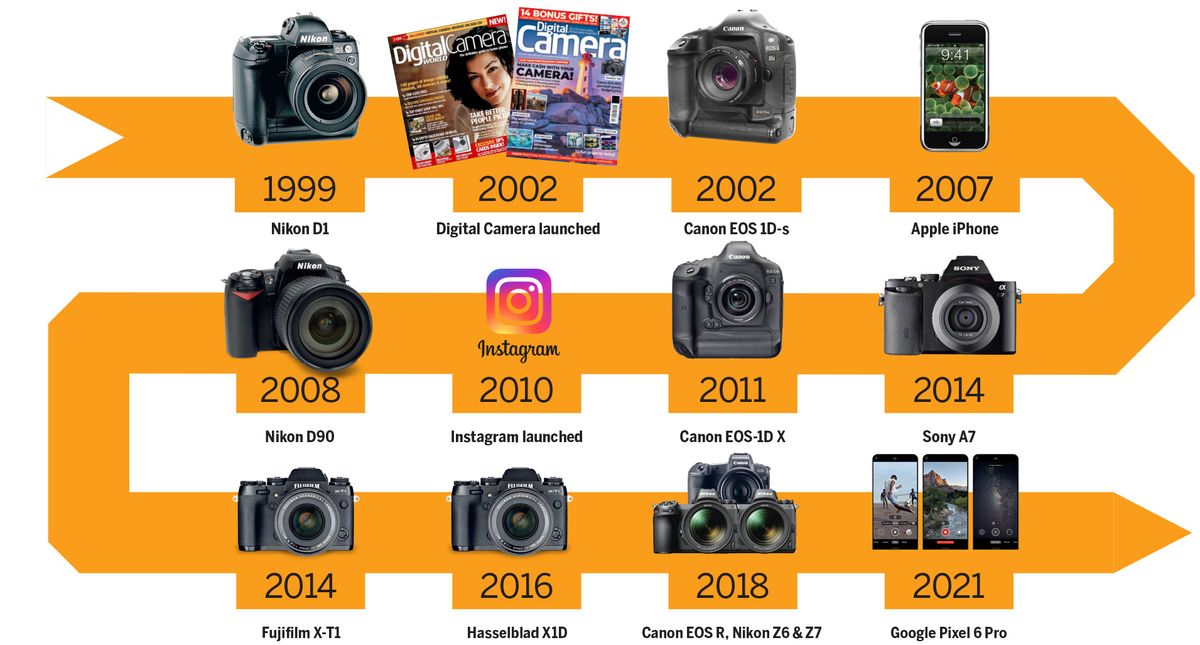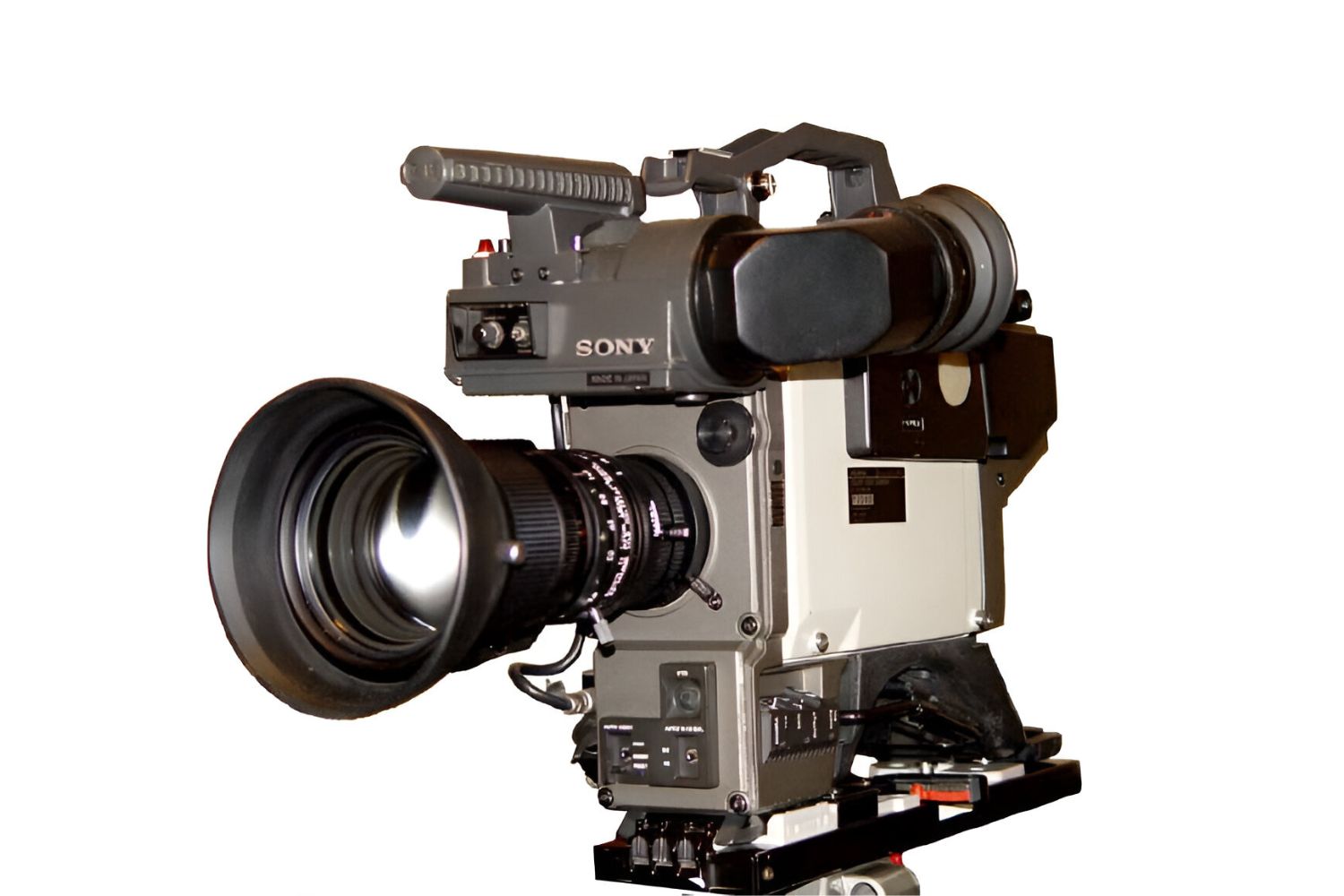Introduction
The advent of digital cameras has revolutionized the way we capture and share our photos, forever changing our relationship with photography. Unlike their analog predecessors, digital cameras capture images electronically, offering instant gratification and endless possibilities for editing and sharing. This technological advancement has had a profound impact on society, influencing the way we document our lives, communicate, and view the world around us.
Gone are the days of waiting for film to develop and prints to be made. With digital cameras, we can instantly view our photos on the camera’s LCD screen, allowing us to retake shots, adjust settings, and ensure we capture the perfect moment. This instant feedback has transformed the way we approach photography, encouraging experimentation and creativity.
Beyond the immediate benefits of instant feedback, digital cameras have also made it easier than ever to share our photos with others. The rise of social media platforms and online photo-sharing websites has allowed us to upload and showcase our images to a global audience with just a few clicks. Whether it’s documenting a milestone, capturing a breathtaking landscape, or snapping a candid moment, digital cameras have empowered us to share our visual stories with the world in real-time.
Additionally, the accessibility of digital cameras has democratized photography. In the past, owning a film camera and the associated costs of film and developing limited photography to enthusiasts or professionals. However, digital cameras, particularly those integrated into smartphones, have made photography accessible to almost everyone. Now, anyone with a smartphone can become a photographer, capturing and sharing moments without the need for expensive equipment or technical knowledge.
In the following sections, we will explore the various ways in which digital cameras have impacted society, from the demise of film photography to advancements in technology, social media influence, changes in perception, and the overall impact on the photography industry and our everyday lives.
Instant Sharing of Photos
One of the most significant impacts of digital cameras on society is the ability to instantly share photos. In the past, capturing a great photo meant relying on physical prints or negatives, which often had to be developed and distributed manually. This process was time-consuming and limited the immediate sharing of images. However, with the rise of digital cameras, sharing photos has become effortless and instantaneous.
Thanks to social media platforms like Instagram, Facebook, and Snapchat, we can now upload and share our photos with a global audience in a matter of seconds. This has transformed the way we communicate and connect with others, enabling us to share our lives visually and in real-time.
The instant sharing of photos has also revolutionized the way we experience events and moments. Take, for example, concerts or sporting events. In the past, attending such events meant relying on professional photographers or waiting for official photos to be released. However, with the prevalence of smartphones equipped with high-quality digital cameras, fans can now capture and share their experiences with the world instantaneously. This has led to a more immersive and participatory culture, where every attendee becomes a potential content creator.
Furthermore, digital cameras have given rise to a new type of visual storytelling through platforms like Instagram Stories and Snapchat. These features allow users to share a series of photos and videos in a chronological narrative format, giving followers a glimpse into their daily lives or special moments. This form of instant sharing has become a popular way to engage with friends, followers, and even businesses, allowing for a more intimate and immediate connection.
However, with the ease of instant sharing comes the challenge of maintaining privacy and controlling our digital image. It’s crucial to be mindful of what we share online and consider the potential consequences. While digital cameras have given us unprecedented sharing capabilities, it’s important to strike a balance between capturing and sharing our lives with others and preserving our own privacy.
In summary, the advent of digital cameras has revolutionized the way we share our photos. Instant sharing through social media platforms has allowed us to connect with others, share experiences, and engage in visual storytelling like never before. However, it’s essential to approach the instant sharing of photos with caution and mindfulness, considering both the benefits and potential risks involved.
Increased Accessibility to Photography
One of the significant impacts of digital cameras on society is the increased accessibility to photography. In the past, photography was something that primarily relied on dedicated film cameras, which required technical knowledge and a considerable investment in equipment and film rolls. This limited the art of photography to a select few who could afford the expensive gear and the ongoing costs associated with it.
However, with the advent of digital cameras, particularly those integrated into smartphones, photography has become accessible to almost everyone. These compact and affordable devices have opened up a world of possibilities, empowering anyone with a smartphone to capture and express their creativity through photography.
The accessibility to photography offered by digital cameras has led to a democratization of the art form. Now, individuals from all walks of life can document their experiences, capture meaningful moments, and tell their visual stories without the need for expensive equipment or technical expertise.
Furthermore, the ease of use of digital cameras has made it possible for beginners to explore and experiment with photography. Unlike traditional film cameras, where mistakes could only be discovered after developing the film, digital cameras provide instant feedback, allowing budding photographers to learn from their shots and improve their skills rapidly.
The accessibility to photography has also been enabled by the vast array of photography apps and editing software available on smartphones and computers. These tools provide filters, editing options, and creative features that further enhance the capabilities of digital cameras and allow individuals to express their artistic vision.
Moreover, the increased accessibility to photography has not only empowered individuals but has also transformed industries such as journalism, blogging, and social media. Professionals in various fields can now visually document and communicate their stories directly to their audiences, bypassing traditional gatekeepers and reaching a wider audience.
However, it is important to note that accessibility does not necessarily equate to expertise. While digital cameras have made photography more accessible, it is still essential to learn the principles of composition, light, and storytelling to capture compelling images. Developing a good eye for photography and honing skills can take time and dedication, even with the technological advancements brought about by digital cameras.
In summary, digital cameras have increased accessibility to photography, providing almost everyone with the means to capture and share their visual stories. This accessibility has democratized the art form, allowing individuals to explore and express their creativity without the need for expensive equipment or specialized knowledge. However, it is still important to invest time in learning the craft to truly master the art of photography.
Demise of Film Photography
The rise of digital cameras has led to the gradual demise of film photography, transforming the way we capture and preserve images. In the past, film photography was the norm, requiring the use of physical rolls of film that needed to be developed and printed. However, with the emergence and widespread adoption of digital cameras, film photography has become increasingly rare, reserved for a niche market and die-hard enthusiasts.
One of the significant factors contributing to the decline of film photography is the convenience and cost-effectiveness of digital cameras. With film, photographers had to carefully consider the number of shots they took due to the limited number of frames per roll. Developing and printing film also incurred additional expenses, making photography an expensive hobby or profession. In contrast, digital cameras allow photographers to take an unlimited number of photos without incurring additional costs, as images can be stored digitally and easily shared online.
Another aspect that has contributed to the demise of film photography is the improved image quality and flexibility of digital cameras. Digital sensors have evolved over time, offering higher resolution, better low-light performance, and the ability to adjust settings such as ISO sensitivity and white balance on the fly. This instantaneous feedback and the ability to make immediate adjustments have made digital cameras more appealing and reliable for capturing high-quality images.
Moreover, the convenience of digital cameras has also played a role in the decline of film photography. Film photographers had to wait for their rolls to be developed and printed before seeing the outcome of their shots. This delay in feedback made it challenging to learn and improve one’s photography skills. Digital cameras, on the other hand, provide instant feedback through the LCD screen, enabling photographers to review their shots and make adjustments in real-time, leading to a quicker learning curve.
The decline of film photography has also led to the closure of many traditional film processing labs and the discontinuation of film stocks by manufacturers. As digital cameras continue to dominate the market, there is less demand for film processing and film-related products, resulting in a shift in the industry towards digital technologies.
Despite the decline of film photography, some photographers still embrace its unique qualities and nostalgic appeal. Film photography offers a different aesthetic, with its grain, color rendition, and distinct look. Many photographers appreciate the hands-on process of shooting with film, from carefully selecting the right film stock to the manual operation of the camera. Film photography has also experienced a resurgence among a niche group of photographers who enjoy the challenge and artistic expression it offers.
In summary, digital cameras have led to the demise of film photography as they offer greater convenience, cost-effectiveness, and flexibility. While film photography may no longer be as prevalent as it once was, there are still enthusiasts who appreciate its unique qualities and enjoy the process and aesthetics associated with shooting with film.
Advancements in Photography Technology
The emergence of digital cameras has brought forth a wave of advancements in photography technology, revolutionizing the way we capture and create images. These technological developments have expanded the possibilities of photography, providing photographers with new tools, capabilities, and creative opportunities.
One of the significant advancements in photography technology is the improvement in image resolution and sensor technology. Digital cameras now offer higher megapixel counts, allowing for greater detail and sharpness in images. This advancement has made it possible to capture breathtaking landscapes, intricate details, and vibrant colors with stunning clarity.
Another notable advancement is the improvement in low-light performance. Digital cameras now excel in capturing images in challenging lighting conditions, allowing photographers to preserve the details and ambiance of scenes even in dimly lit environments. This has expanded the boundaries of photography, enabling photographers to capture striking images in low-light situations that would have been difficult or impossible with film cameras.
The advancements in photography technology have also led to improvements in autofocus systems. Modern digital cameras feature advanced autofocus mechanisms that can track subjects accurately and quickly, ensuring that photographers can capture sharp and well-focused images, especially in fast-paced situations such as sports or wildlife photography.
Additionally, advancements in photography technology have led to the integration of image stabilization features in digital cameras. This technology compensates for camera shake and reduces blur, allowing photographers to capture sharp images even when shooting handheld or in low-light conditions. Image stabilization has opened up new possibilities, enabling photographers to shoot with slower shutter speeds without the need for a tripod and capturing sharp images in situations where stability is challenging.
Furthermore, digital cameras now offer a wide range of shooting modes and creative options that allow photographers to explore their artistic vision. These include various scene modes, creative filters, and in-camera effects that can be applied to images. The availability of these features has made it easier for photographers to experiment with different styles, moods, and artistic expressions.
Another significant advancement in photography technology is the integration of video capabilities in digital cameras. Many modern digital cameras now offer the ability to capture high-quality videos, opening up new avenues for photographers to express their creativity and tell visual stories through motion. This convergence of photography and videography has further expanded the boundaries of visual storytelling.
Lastly, the advancements in photography technology have resulted in smaller, more compact cameras without compromising on image quality. Mirrorless cameras, in particular, have gained popularity for their smaller form factor, lightweight design, and advanced features. These cameras offer a balance of portability and performance, allowing photographers to travel and capture images without the burden of bulky equipment.
In summary, advancements in photography technology have transformed the way we capture images, offering higher resolution, improved low-light performance, advanced autofocus, image stabilization, creative options, video capabilities, and smaller form factors. These technological advancements have expanded the possibilities of photography, empowering photographers to push their creative boundaries and capture stunning images.
Influence on Social Media and Online Platforms
The advent of digital cameras has had a profound influence on social media and online platforms, transforming the way we share and consume visual content. With the widespread adoption of digital cameras, particularly those integrated into smartphones, capturing and sharing photos has become an integral part of our online presence and communication.
Social media platforms such as Instagram, Facebook, Twitter, and Snapchat have become the go-to channels for sharing and discovering visual content. Photos captured with digital cameras can be instantly uploaded and shared with a global audience, allowing individuals to showcase their creativity, experiences, and perspectives in real-time.
Visual storytelling has become a powerful tool for individuals and brands alike, creating a more immersive and engaging online experience. Digital cameras have given users the ability to capture and share their stories visually, capturing the attention and curiosity of viewers. Whether it’s showcasing a breathtaking travel destination, sharing mouth-watering food creations, or documenting personal milestones, digital cameras have enabled users to tell their stories in a compelling and relatable way.
The influence of digital photography on social media and online platforms goes beyond personal sharing. Businesses and brands now rely heavily on visually driven content to connect with their audience and promote their products or services. High-quality photos captured with digital cameras allow businesses to showcase their offerings in an attractive and appealing manner, helping to create a strong brand aesthetic and capture the attention of potential customers.
In addition, the rise of influencer marketing on social media platforms has been directly influenced by the accessibility and popularity of digital cameras. Influencers, who produce visually engaging content, leverage their digital cameras to create high-quality images that resonate with their followers. By posting curated photos and documenting their experiences, they have become powerful marketing tools, effectively influencing consumer behavior and shaping brand perceptions.
Moreover, the popularity of visual-centric platforms such as Pinterest and TikTok can also be attributed to the influence of digital photography. These platforms thrive on user-generated visual content, encouraging users to capture and share their creativity, inspiration, and ideas. Digital cameras have provided the tools necessary for users to create unique and engaging content, contributing to the growth and success of these platforms.
However, the influence of digital photography on social media and online platforms also comes with its challenges. With the prevalence of photo editing software and filters, there is a risk of creating unrealistic expectations or altering perceptions. It’s important to use digital cameras and editing tools responsibly, maintaining authenticity and ethical practices while creating and sharing visual content.
In summary, digital cameras have played a significant role in shaping social media and online platforms, enabling individuals and businesses to share and consume visually-driven content. From personal storytelling to brand promotion, digital photography has enhanced the online experience, creating a more engaging and visually appealing digital landscape.
Changing the Way Photography is Perceived
The advent of digital cameras has brought about a significant shift in the way photography is perceived by both creators and consumers. Digital photography has not only democratized the art form but has also altered the way we view and appreciate images.
One of the key changes in perception is the shift towards a more casual and spontaneous approach to photography. With digital cameras, particularly those integrated into smartphones, capturing a photo has become a quick and effortless process. This ease of use has led to an increase in the number of photos taken and shared, resulting in a shift from meticulously staged compositions to capturing candid moments and everyday experiences. The emphasis is no longer solely on technical mastery but on capturing the moment and telling a story.
Digital photography has also given rise to a culture of instant gratification. With the ability to preview images immediately on the camera’s LCD screen, photographers can assess the results instantly and make adjustments if necessary. This immediate feedback loop has accelerated the learning process and encouraged experimentation, ultimately changing the way photographers approach their craft.
Furthermore, the rise of social media platforms and online photo-sharing websites has influenced the way we perceive photography. Images are now shared and consumed on a global scale, allowing individuals to curate and present their visual narratives to a wide audience. This has created a sense of competition and comparison in the realm of photography, where the number of likes, shares, and comments often becomes a measure of success and validation. Consequently, there is a greater emphasis on creating visually striking and attention-grabbing images.
Additionally, the rise of digital photography has blurred the boundaries between amateur and professional photographers. With the accessibility of digital cameras and photo editing software, anyone can now produce high-quality images and showcase their work online. This has challenged the traditional perception of photography as an exclusive art form limited to professionals. As a result, there is a greater appreciation for the diverse perspectives and unique styles that emerge from both amateurs and professionals alike.
Moreover, the abundance of digital photos has changed our relationship with physical prints. In the age of digital photography, we have become accustomed to accessing and viewing our images digitally on devices such as smartphones, tablets, and computers. The physical print, once cherished as a keepsake or a form of artistic display, has become more uncommon. However, there is still a growing appreciation for printed photography as a tangible and lasting form of art, emphasizing the value of preserving and displaying photographs in a physical form.
In summary, digital photography has brought about significant changes in the perception of photography. The emphasis has shifted towards a more casual and spontaneous approach, with an emphasis on instant gratification and creating visually striking images. The rise of social media has also influenced our perception, creating a sense of competition and validation based on online engagement. Furthermore, digital photography has challenged the distinction between amateurs and professionals, fostering an appreciation for diverse perspectives and unique styles. While the physical print has become less common, there is still a growing appreciation for the tangible nature of printed photography.
Impact on the Photography Industry
The advent of digital cameras has had a profound impact on the photography industry, reshaping the way photographers work, the services they offer, and the overall business landscape. The advancements in technology and the accessibility of digital cameras have disrupted traditional photography practices, presenting both challenges and opportunities for photographers and industry professionals.
One of the significant impacts of digital cameras on the industry is the shift from film to digital photography. The demand for film processing and printing services has decreased drastically, leading to the closure of many traditional film labs and a decline in the production of film stocks by manufacturers. As a result, photographers and industry professionals have had to adapt to the digital landscape, acquiring new skills and knowledge to thrive in a primarily digital industry.
Furthermore, the accessibility and affordability of digital cameras have led to an increase in the number of photographers in the market. With smartphones equipped with high-quality cameras, almost everyone has the potential to be a photographer. This increased competition has made the photography industry more competitive, forcing photographers to differentiate themselves and offer unique services or styles to stand out in a crowded market.
Additionally, the rise of digital photography has also changed the way photographers deliver their services. With the ability to capture a large number of photos without the need for physical prints, photographers can now provide clients with digital image files, speeding up the delivery process and reducing costs associated with printing and packaging.
The digital landscape has also opened up new avenues for photographers to showcase and sell their work. Online platforms and marketplaces have emerged, allowing photographers to reach a global audience and sell their images directly to consumers. This direct-to-consumer model has given photographers more control over their work and revenue streams, bypassing traditional intermediaries and galleries.
Moreover, digital cameras have led to a significant shift in photography workflows and post-processing techniques. Image editing software and tools have become integral to the photography process, allowing photographers to enhance and manipulate images with greater control and precision. This has broadened the creative possibilities for photographers, enabling them to deliver visually compelling and impactful images to clients.
However, the increased accessibility and ease of digital photography have also led to challenges in the industry. The sheer volume of digital images being captured and shared online has led to oversaturation and a devaluation of photography as a whole. With the availability of free stock photography and the prevalence of amateur photographers willing to work for little to no fee, professional photographers must continuously demonstrate their expertise, creativity, and value to potential clients.
In summary, digital cameras have had a profound impact on the photography industry, from the shift to digital workflows and the decline of film to the increased competition and the emergence of new business models and marketplaces. The industry must continually adapt to advancements in technology and changing consumer behaviors to thrive in the digital era.
Economic Implications
The widespread adoption of digital cameras and their impact on the photography industry has significant economic implications, affecting various stakeholders in the market. The advancements in digital technology and the accessibility of digital cameras have reshaped business models, revenue streams, and consumer behavior within the industry.
One of the major economic implications is the reduced cost for photographers and consumers. Digital cameras and the elimination of film and processing expenses have significantly lowered the overall cost of photography. Photographers no longer need to invest in film rolls, development, or printing, reducing their operational costs. This, in turn, has allowed photographers to offer more affordable services to clients and reach a wider customer base.
The reduced cost of digital photography has also resulted in changes in consumer behavior. As the barrier to entry has been lowered, more individuals now have access to photography services. This has led to increased demand for photography for personal use such as portraits, family events, and special occasions. Additionally, the affordability and accessibility of digital cameras have encouraged more people to pursue photography as a hobby or part-time profession.
Furthermore, the shift to digital photography has created new income streams for photographers. While traditional print sales have declined, photographers can now generate revenue through various digital platforms. Online marketplaces, stock photography websites, and licensing agreements allow photographers to sell their images directly to individual buyers, businesses, and publishers. This provides photographers with opportunities to monetize their work beyond traditional print sales.
The rise of social media and online platforms has also had economic implications for photographers. Platforms like Instagram and Pinterest have become powerful marketing tools, enabling photographers to showcase their work, gain exposure, and attract clients. Influencer marketing has become a viable revenue stream for photographers, as they can collaborate with brands and monetize their large social media followings.
However, the increased accessibility of digital photography has also created challenges in terms of market saturation and price competition. With a larger pool of photographers offering their services, there is more competition for clients, putting downward pressure on prices. Photographers must differentiate themselves and demonstrate their unique value proposition to stand out in a crowded market.
Another economic implication is the impact on traditional photography businesses, such as film labs and printing studios. With the decline in demand for film processing and printing, many traditional businesses have had to adapt or close their doors. On the other hand, new business opportunities have emerged in the digital realm, such as online printing services and website builders tailored for photographers, providing new avenues for revenue generation.
In summary, the economic implications of digital photography are multi-faceted. It has reduced the cost of photography for both photographers and consumers, changed consumer behavior and created new income streams. However, increased competition and market saturation have created challenges in maintaining profitability. As the industry continues to evolve, photographers and photography-related businesses must adapt their strategies to thrive in the digital era.
The Digital Camera in Everyday Life
Digital cameras have become an integral part of our everyday lives, shaping how we document and experience the world around us. From smartphones to dedicated digital cameras, these devices have revolutionized the way we capture, share, and interact with photography on a daily basis.
One of the key roles of digital cameras in everyday life is as a tool for personal expression and storytelling. Whether it’s snapping a quick selfie, capturing a beautiful sunset, or documenting memorable moments with loved ones, digital cameras empower us to visually capture and immortalize our experiences.
Moreover, digital cameras have transformed how we communicate and connect with one another. The ability to instantly capture and share images has made photography a universal language, allowing us to convey emotions, experiences, and stories in a visual format. From sharing vacation photos to documenting milestones, digital cameras have enriched our communication by enabling us to share our world with others in a more immediate and personal way.
Furthermore, digital cameras have also changed the way we perceive and remember memories. In the past, we relied on physical photo albums or printed pictures to relive past moments. Now, with digital cameras, we have vast digital libraries of photos that can be easily accessed and organized. This has made it simpler to preserve and revisit memories, as well as share them with future generations.
Additionally, the availability of image editing software and filters has added a new dimension of creativity and fun to everyday photography. With just a few taps or clicks, we can enhance our photos, apply artistic effects, or create collages. This has sparked a wave of user-generated content on social media platforms, where people can showcase their creativity and unique perspectives.
The digital camera’s integration into smartphones has also transformed them into all-in-one devices, serving as our primary means for capturing, storing, and sharing photos. This convenience has made photography a seamless part of our daily lives, allowing us to capture spontaneous moments, share them instantly on social media, and relish the immediate feedback from friends and family.
Moreover, digital cameras have enabled us to explore and appreciate the world around us in new ways. With high-quality cameras at our fingertips, we have become more observant of the beauty and intricacies of everyday life. From capturing stunning landscapes to focusing on small details, digital cameras have encouraged us to find inspiration in the ordinary and fostered a greater appreciation for the world’s visual richness.
In summary, the digital camera has become an indispensable tool in our everyday lives, shaping how we capture, share, and experience photography. It facilitates personal expression, strengthens connections with others, enhances communication, and fosters creativity. As digital cameras continue to evolve, they will undoubtedly play an even more prominent role in shaping our daily experiences and preserving our memories.
Conclusion
The digital camera has undoubtedly revolutionized society’s relationship with photography. From the instant sharing of photos, increased accessibility to photography, and the demise of film photography, to the advancements in photography technology and its influence on social media and online platforms, the impact of digital cameras has been profound.
With digital cameras, capturing and sharing photos has become seamless, allowing us to instantly document and connect with others in a visual language. The accessibility of digital cameras has democratized photography, enabling almost everyone to express their creativity and share their visual stories with the world. This has transformed how photography is perceived, emphasizing spontaneity, instant gratification, and casual approaches to the art form.
Advancements in photography technology, such as improved image resolution, low-light performance, and autofocus systems, have expanded the possibilities for photographers, enhancing the quality and creativity of their work. The influence of digital photography on social media and online platforms has created a digital landscape where visual storytelling and engagement flourish.
The impact of digital cameras extends beyond individuals and has affected the photography industry as a whole. It has presented both challenges and opportunities, such as the decline of film photography, the emergence of new business models, and the need for photographers to adapt and differentiate themselves in a competitive market.
Economically, digital cameras have reduced the cost of photography for both photographers and consumers while providing new avenues for revenue generation through digital platforms and licensing agreements. The integration of digital cameras into everyday life has transformed how we communicate, remember, and appreciate our experiences, fostering creativity and enhancing our visual perception of the world.
As we move forward in the digital era, the impact of digital cameras will continue to shape how we capture and interact with photography. It is an exciting time where emerging technologies and trends will continue to influence and redefine the art form, paving the way for further innovation, expression, and connection through photography.

























